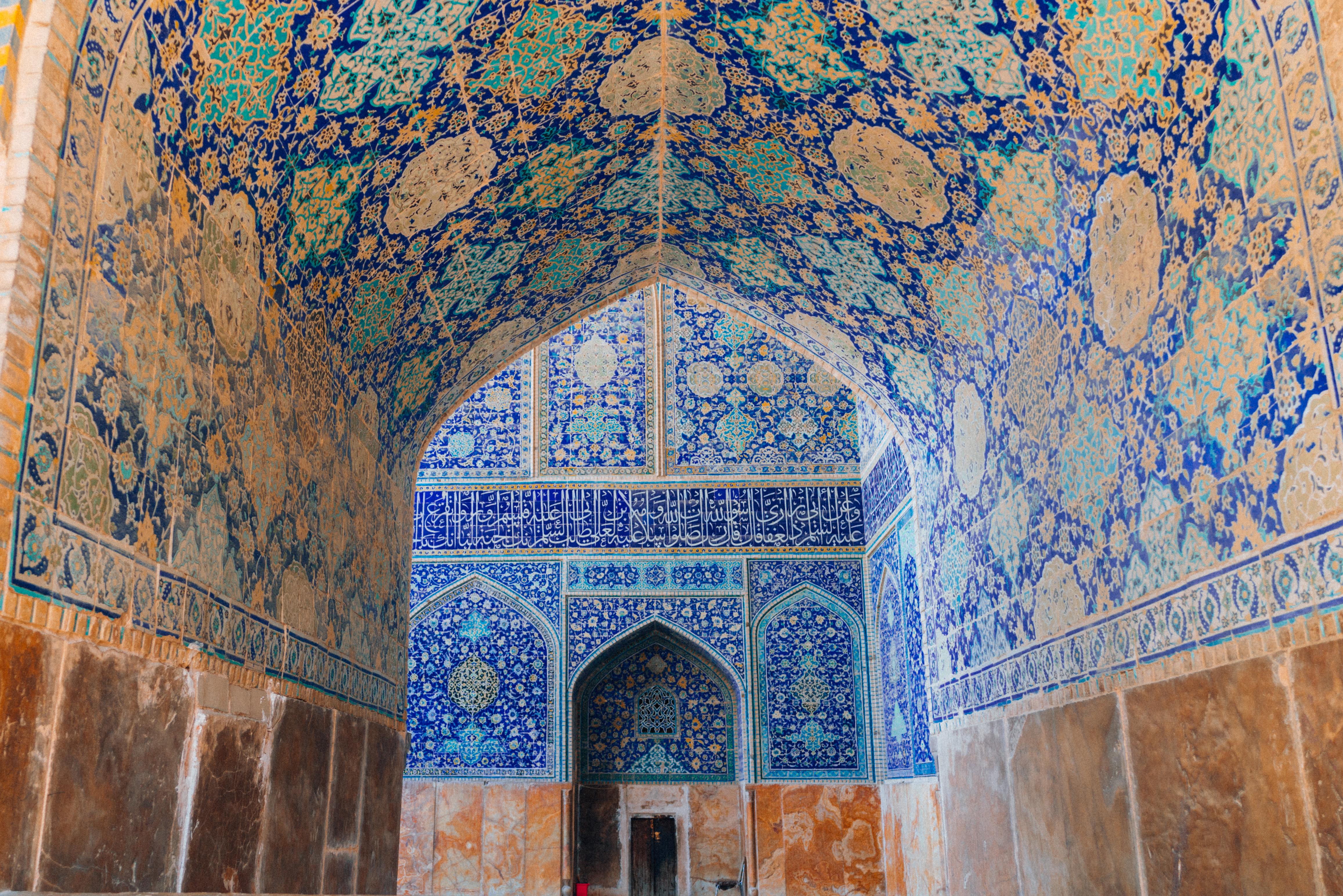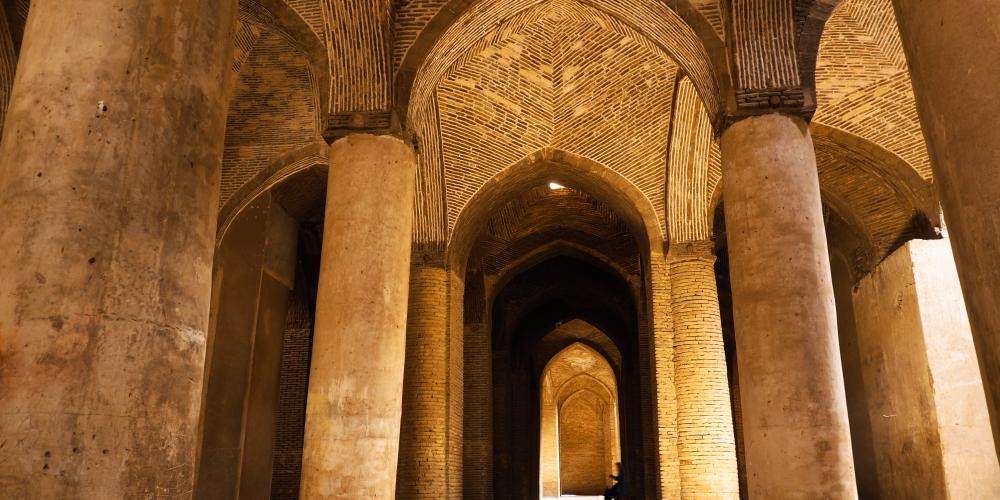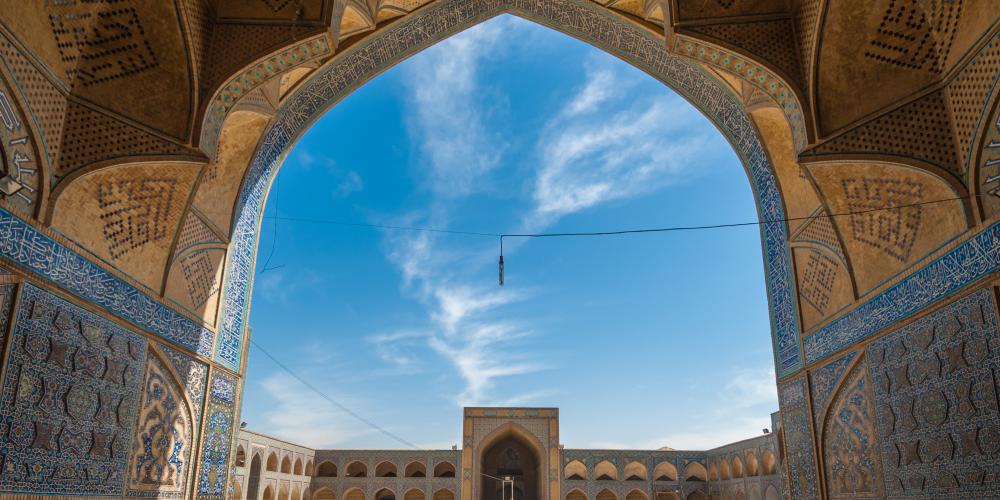Masjed-e Jame Isfahan

As the centuries went by and empires rose and fell, the countless rulers of Isfahan each wanted to make their mark on the city's icon - the Great Mosque of Isfahan, also known as Masjed-e Jāmé. Constantly remodelled with each sovereign trying to upstage the last, the mosque transformed into a grandiose display of power, a reflection of its leaders. Growing bigger and more intricate over the years, the site became not just a mosque, but a sanctuary for its community. Many of Masjed-e Jāmé's features were designed as a safe, quiet atmosphere for some respite and, by bringing residents off the streets and into prayer, the congressional mosque has united Isfahan for hundreds of years.

The four iwan courtyard design of Masjed-e Jāmé was revolutionary at the time. It was the first mosque to adopt this configuration, which was then replicated for centuries across the Islamic world. Inspired by Sassanid architecture, the open courtyard was surrounded by four high rectangular ceiling structures called iwans, each with three walls and a large opening. The entrances to the iwans are decorated in colourful tiles, glimmering in gold and blues, with the most impressive being the southern Qibla iwan, facing Mecca. It has two minarets rising up above its entrance and a large dome behind it.
On the northern side of the mosque is the Taj al-Mulk Dome, which has captivated builders and visitors for centuries. Built in 1088, it is famous for its mathematical perfection and is considered one of the finest in Persia. But it's just one of the remarkable features within Masjed-e Jāmé. Effectively a museum of the greatest Islamic design styles in history, other highlights include the central fountain designed to replicate the Kaaba at Mecca, and the prayer hall in the western side with elaborately-carved stucco.
History
This World Heritage site’s history dates back to 771, when the first mosque was made out of earthen material during the Abbasid Caliphate. The small structure was replaced in 841 with a much larger building including a large courtyard accompanied by a hypostyle hall in traditional stucco design. Around 975, during the Buyid dynasty, the mosque saw its first embellishments of intricate brickwork and lavish designs.
The Seljuk Empire (11th century) receives credit for the countless additions and remodelling that makes the site so magnificent. The most notable being the construction of the Taj al-Mulk and Nizam al-Mulk domes built in 1086-87 and 1088-89 respectively. At the time, Nizam al-Mulk was the largest masonry dome in the Islamic world and was copied for its new type of squinch, or dome structure. These domes are recorded as being some of the only structures to survive the fire of 1122.

In the early 12th century the mosque underwent several major transformations that made it into the iconic landmark it is today. The most notable being the four-iwan design that has been replicated in mosques all around the world. Other adjustments like the two layered arcade and the addition of several new prayer halls came in the early 1300s.
Over the years, rulers have continued to improve the mosque, attempting to leave their mark on history. From design embellishments to lengthy additions, the mosque has adapted to the ruler's requests and the needs of the community, leading it to be one of the largest and most intricate mosques in the world.
Site Today
The Great Mosque’s urban integration has made it a pillar of the Isfahan community. Sitting in the heart of the city, the mosque is mixed into the daily lives of the city's residents. It has become a centre for travel, trade, and everyday activity. Locals can be seen gathering with friends and family for picnics and evening strolls around the mosque.
Today, Masjed-e Jāmé is located in the third-largest city in Iran and the provincial capital. Despite the urban development, the mosque transports visitors hundreds of years into the past, offering a fascinating insight into the heritage of Isfahan. The breathtaking structure symbolises resilience as it has withstood fires, earthquakes, and hundreds of years of modifications. Its original beauty has been preserved and restored for future generations to enjoy.

How to get there
The mosque's close proximity to Imam Ali Square makes arriving by bus convenient and easy. Take line 47, 52, 53, or 71 to be dropped off right in front of the mosque.
Invest in a Isfahan card which can be used to ride the bus. It will save you money and can be used as many times as you would like. Keep in mind that men will have a section in the front of the bus and women will have a separate section in the rear of the bus.
If you are looking for a personal transfer, consider taking a taxi, which can be found all around the city. For a cheaper and safer experience download SNAPP or TAP30. These rideshare apps work great when getting around town.
Isfahan is easily accessible from major cities like Tehran and Mashhad by plane. Isfahan International Airport (IFN) is only a thirty minute drive from Masjed-e Jāmé. Share a taxi or use a rideshare app for the cheapest transportation.
Isfahan has a great network of public transportation, with options for everyone. Connected to other major cities by bus, train and metro as well.
When to visit
Masjed-e Jame is open from 9:00 am to 12:00 pm and from 2:00 pm to 4:30 pm everyday. To avoid crowds and the heat of the high sun, visit in the morning. Make sure you leave yourself enough time to see everything, the mosque closes to tourists at noon for afternoon prayer.
To experience its beauty in a different light, stop by the mosque at night. Pack a picnic and join the locals that gather in the Naqsh-e Jahan Square on weekends to spend time with their family and friends.
The best time to visit Isfahan is in April and May. These spring months will give you the best weather and will avoid the crowds of peak season.
How to Visit
When visiting, remember that Masjed-e Jame is a functioning mosque, and guests need to act respectfully. Women should leave very little skin exposed, wearing a hijab, a long sleeve shirt and long pants is expected. Men will need to wear long pants and avoid sleeveless shirts.
In addition to this, avoid loud conversations and horseplay. The mosque is a sacred place and needs to be treated as such. Follow closures and be respectful of the mosque's etiquette. Feel free to take photos of the mosque, but avoid capturing any of the worshippers before or during their prayer time.
For the best experience, hire a local guide to take you in and around the mosque. Hear about thousands of years of history from a local expert. Listen to tales of ancient rulers and architects of the mosque's inspiring past. Follow your guide through the tombs, hidden areas and secret prayer rooms.
For guests visiting on their own, 30 minutes is an appropriate time to walk through the entire mosque. If you are planning to take in the intricate designs and immense history, plan to stay for about two hours. Wander around at your own pace and explore the ins and outs of the largest mosque in Iran.
After visiting Masjed-e Jāmé, walk over to the Grand Bazaar, which has its main entrance connected to the Friday mosque. Here you can buy Persian handicrafts and find a place to enjoy lunch or a coffee.
There was a time when Masjed-e Jāmé had multiple entrances and it was a bustling thoroughfare for the people of Isfahan. Now, the central open-air space offers some tranquillity within Iran's third-largest city, the silence broken only by the chants of prayer echoing through the halls. The four iwans on each side of the mosque have dazzling entranceways decorated with vibrant turquoise and golden tiles, while wandering through the hypostyle halls reveals detailed tilework, intricate stucco designs, and clever lighting effects. When you're ready, head outside into the tireless Grand Bazaar that encroaches the southwest wing of the mosque.


